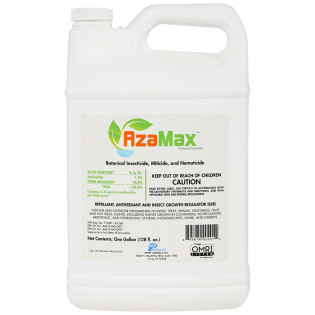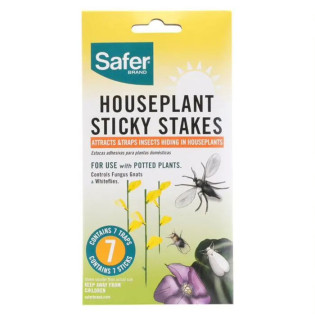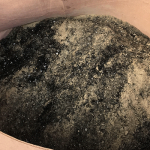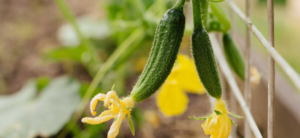
While they are less known than aphids or mites, it’s important that you understand how to get rid of springtails on plants too.
Dealing with these bugs on your plants can be frustrating, but you’re not alone. They are commonly found indoors but also lurk in the garden. Anywhere in which they can find tasty plants to munch on, they will make their home.
They are secretive little buggers, too, often hiding signs of infestation until it’s too late - when the plant starts showing serious symptoms.
Fortunately, there are some steps you can take to prevent springtail infestations.
By knowing exactly what these pests are and how to get rid of springtails in plants, you’ll be able to get on top of the situation before it ever becomes a problem.
What Are Springtails?
Once considered insects, springtails are now viewed as hexapods since they have unique chewing mechanisms that bumped them out of the insect category.
They are microscopic pests that are difficult to see with the naked eye. You might see them when they jump but don’t blink too quickly or you’ll miss them!
As arthropods with six legs, springtails have a three-segmented thorax and only grow up to ⅛” long. They are wingless and found in colors like white, brown, black, and gray.

Cylindrical in shape, these pests have mouths that react back into their heads, needle-like mouths, and eight eyes.
If that sounds like something out of a horror movie, just wait - there's more. These pests move long distances using their tails, which have forked appendages known as furculas.
When frightened, fluid rushes to the springtail’s furcula so it can fling itself a distance up to 100 times its body length!
Springtails are most commonly found in damp areas. They don’t like dry environments, so you aren’t likely to find them in drought-like conditions. They have special proteins in their bodies that allow them to survive the harshest winters. Of the world’s more than 6000 springtail species, North America has nearly 700!
Are Springtails Bad For Plants?
If you’re thinking that a springtail bug infestation might be a problem you can simply ignore, think again. Springtails are very bad for plants, and can easily overtake and destroy a garden or grow room.
For starters, they feed on the roots. This alone can kill your plants, as it will prevent the roots from uptaking moisture and nutrients to the plant. In essence, this will starve and dehydrate your plants.

Most plants can recover from root damage. But if it spans more than a quarter of the plant’s roots, it can be devastating. You’ll know the roots are dying when your plant begins to wilt and yellow.
Springtails also feed on algae, mold, and fungi. You might notice signs of these problems if you have springtails, too.
It can be tough for your plant to bounce back from a springtail infestation once it’s set in for good. This is why learning how to get rid of springtails in plants is so important.
Do Springtails Go Away On Their Own?
You can’t ignore an infestation because these springtails will not go away on their own.
Pests are drawn to organic material and moisture. They like to live in or under decaying bark and wood. They thrive in places where organic mulches, compost, and leaf litter are plentiful.

As it turns out, these are the exact conditions you’ll find in the garden, and even in your container grown plants.
Although they might seem to disappear every now and then, the reality is that they’ve probably changed up their habitat as the environmental conditions change. This means they’ll return when the seasons change, making them a recurring issue for you and your garden.
In fact, during prolonged dry spells, springtails prefer indoors. Springtail bugs will head indoors in a hunt for moist areas. They can sometimes become trapped in places like washbasins and sinks as a result. They also love swimming pools.
How To Prevent Springtails In The Garden
An ounce of prevention is worth a pound of cure. Luckily there are some steps you can take to mitigate the risk of a springtail infestation in your plants.
The protocols will differ for indoor growing and outdoor growing, but we will explain options for both types of gardens now.
Use Diatomaceous Earth

Springtails reproduce prolifically, making them hard to prevent outdoors. However, one of your best avenues of defense is to sprinkle diatomaceous earth in the soil.
Diatomaceous earth is a substance that is safe for use around pets and people. It works by desiccating the body of springtails and killing them as they crawl upon it. Learn more about how to use diatomaceous earth in the garden by reading our complete guide.
Optimize Your Environment & Seal Your Indoor Growing Space

Indoor growing spaces are perhaps even more vulnerable to springtail infestations. The good news is that they are easier to control indoors.
They love moist, humid conditions, which are common in houseplants, hydroponic grow rooms, grow tents, and grow rooms.
Creating sealed, sterile growing conditions is crucial to preventing not just springtails - but every type of common grow room pest or disease you can imagine.
This involves managing temperature and humidity of course, but also providing ample airflow, and exchanging air by setting up a ventilation system. Learn more in our complete guide on grow room atmosphere and ventilation.
Other Tips For Preventing Springtails In Plants

Ensure you occasionally inspect your plants and remove pests as you find them.
In any growing environment, let the soil around your plants dry completely before watering. This will prevent springtails from becoming established.
You may want to consider reducing watering in ornamental or vegetable gardens that are known to host springtails, too.You should also place some sticky traps in your potted plants. These will reduce springtail reproduction. This will slow the infestation rate. You will gain control of the situation.
How Do You Get Rid Of Springtails In Soil Plants Naturally?
As with preventing springtails, treatment for springtails can also be done with a dose of diatomaceous earth. This will repel pests from entering the soil and kill the ones that are already there.
If you think you may have springtails in your plants, press down with your thumb and watch for springing. Remove lichen and other soil covers that are food sources for these pests.
If a soil infestation continues, you can use a non-toxic, bio-degradable treatment to kill and ward off the bugs.
You may have to apply multiple treatments to eradicate a large number of springtail bugs. A soil drench is a good option, especially for nesting sites. There are chemical treatments you can use but one of the most effective natural options is neem oil.
Try Using Neem Oil First

Neem oil is perfect for small infestations of springtails along with other kinds of pests. It burns the springtails and also suffocates them as it coats their entire bodies.
To apply a neem oil treatment, all you need to do is mix together a combination of water and neem oil. From there you simply add to a garden sprayer and apply to the foliage, or simply drench the roots if that’s where the majority of your springtails are residing.
Wait 24 hours for a reaction, then apply again if you still see high insect activity. You may begin to see clusters of springtails very shortly after. For more information on how to use neem oil in the garden, check out our detailed guide!
How To Get Rid Of Springtails By Spraying Insecticide

Sometimes, neem oil won’t be strong enough for a serious springtail infestation. In these instances, you’ll need something more potent - an insecticide.
The reality is, they’re an important aspect of any integrated pest management strategy. When used properly, they are perfectly safe for you and your plants.
Here at Hydrobuilder, there are several great options that are OMRI listed for organic production, including azadirachtin. This is an antifeedant and insect growth regulator that stops the spread of pests through starvation.
What Spray Kills Springtails?
Don’t just grab any pesticide and start spraying your plants. There are a few in particular that will produce far better results than others.
General Hydroponics AzaMax Concentrate
This spray is ideal for hydroponic growers who are struggling with a springtail infestation.
It contains azadirachtin A&B as active ingredients along with more than 10 different limonoids to make it effective against beetles, worms, leafhoppers, scales, nematodes, and of course, springtails.
PyGanic Gardening
You might also consider the PyGanic Gardening spray. This spray is an organic, broad-spectrum insecticide that kills on contact.
It can be applied in various ways. These include spraying, making it suitable for both hobby and commercial gardeners.
Sierra Natural Science 203 Pesticide Concentrate
Another option is the Sierra Natural Science 203 Pesticide Concentrate. This pesticide is made up of rosemary and clove extracts, so you’ll feel good about what you’re putting on your plants.
It works by attacking the algae and fungus that provide food sources for pests on and around your plants.
Flying Skulls Nuke Em Concentrate
Last on our list is the Flying Skulls Nuke Em Concentrate. This product offers multiple benefits in that it is a multipurpose chemical that serves as both an insecticide and fungicide.
It will kill the larvae, eggs, and juvenile, and adult pests that feed on and kill your plants.
It targets thrips and spider mites, mealybugs, and whiteflies, in addition to springtails on your houseplants.
Final Thoughts On How To Get Rid Of Springtails
Ready to get rid of springtails for good? Although these pests aren’t the most intrusive garden pests you’ll have to deal with, they’re still frustrating, to say the least!
If preventative measures aren’t working for you, give a few of these recommended sprays a try.
By knowing how to get rid of springtails and taking targeted steps to prevent them, you’ll be on the right track in no time.
































